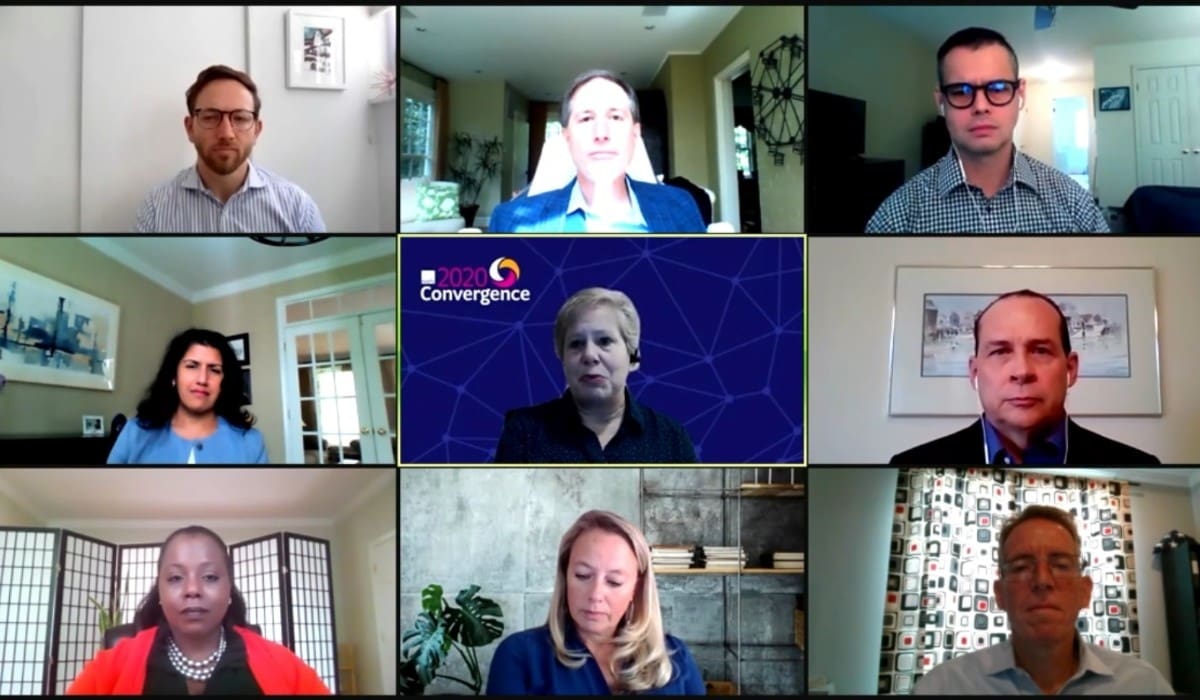ARTICLE SUMMARY:
From Market Pathways’ editors: COVID-19 response remains the top priority, but FDA device center officials (pictured at the RAPS 2020 Convergence meeting September 15) say they are putting together a draft guidance to communicate how they might transition to address emergency authorizations, enforcement discretions, and streamlined practices post-pandemic.
[For a complete roundup of medtech policy happenings that should be on your radar this week, deeper analysis of the sector, and a comprehensive inventory of global medtech policy documents check out Market Pathways. If you don’t subscribe, sign up for a free trial.]
FDA’s device center is preparing to float a plan for how it will eventually transition its regulatory operations out of a COVID-19 emergency footing, even as officials stress that responding to the pandemic will remain the agency’s top priority for the foreseeable future. A draft guidance is under development that will lay out the center’s proposals to shift from a world of Emergency Use Authorizations and enforcement discretions to more traditional regulatory controls “when the time comes,” according to CDRH Director Jeff Shuren.
“We are not anticipating any big changes any time soon,” Shuren said during a September 15 session at the RAPS 2020 Convergence virtual meeting. “But we also think it is a good time to get feedback on what an appropriate transition should look like.”
The top-line issues that would be addressed in such a guidance are how to handle 1) the hundreds of products that have been granted EUAs once the US pulls out of the formally declared public health emergency, and 2) the dozens of enforcement discretion policies allowing products to be marketed outside of their approved indications to support COVID-19 care or remote healthcare in general.
It is anticipated that devices granted emergency authorization will ultimately need to transition to a standard regulatory pathway like a De Novo or 510(k), but with the vast number of products the have been brought to beare on this public health emergency, device firms and others are anxious to get more assurances about next steps. Via guidance documents, FDA has allowed many remote monitoring and digital tools in particular to be employed in new healthcare environments, whether it is a hospital product that is not being used in the home or vice-versa. Backtracking on those types of shifts is not going to be easy, companies note.
“Our goal is to provide predictability and sufficient time for transition,” Shuren said. “We will put that out in draft guidance and seek public comment.”
Other CDRH officials who joined Shuren during the session hinted that the agency is not planning on just wiping away all of the COVID-19 product work it has done post-pandemic.
Bill Maisel, who leads CDRH’s Office of Product Evaluation and Quality, confirmed that the center is looking closely at all of the “immediately in effect” guidance documents and enforcement discretion policies that have been handed down over the past seven months, and “considering which policies should outlive the pandemic.” In particular, he suggested the agency is likely to stick with some pandemic-era policies that increased flexibilities for home-use devices.
Timothy Stenzel, who heads the diagnostics office, noted that FDA has not historically forced EUA tests off the market once select products earn full marketing authorization. “We don’t know what is definitely going to happen with the EUAs that we have made, but it has not been our practice, even though there are certain legal requirements once we grant the first De Novos in a particular category for a previous EUA test, it has not been our practice to remove other tests once those tests achieve full authorization.”
Stenzel also aligned with Maisel’s sentiment that the agency is getting more comfortable with patients handling more healthcare activities with home devices, citing the diagnostics office’s increasing work with self-collection devices for COVID-19 testing samples and the prospects of allowing self-collection in more instances post-pandemic.
Process Reforms
Agency officials also made clear that its post-COVID transition plan will not just be about specific devices, but also about what practices that have been adopted out of necessity in recent months might inform longer term regulatory approaches for all devices.
“We have gained a lot of efficiencies in trying to cut out unnecessary burdens in the review process, our interactive review,” Maisel said of the COVID era. “We are in the process of compiling those lessons learned and thinking about which ones should persist after the pandemic.”
Stenzel pointed to the multiple EUA templates that have been developed for different types of COVID-19 tests, including molecular tests, antibody assays, and home-based tests, and have streamlined the submissions and review process. “We are already thinking along the same lines for non-COVID related work,” he said. “How can we streamline our recommendations for other areas so it is very clear what developers can do to validate their tests in other areas, such as oncology?”
Shuren said it would be the “greatest tragedy” if FDA didn’t apply lessons learned from the pandemic to normal operations. The center is focused on developing ways to carry forward some of the flexible approaches to policy and guidance development and industry engagement it has achieved in recent months, he said. He also wants to further expand how the center leverages its total product lifecycle approach to regulation, with more seamless interactions between pre- and post-market staff.
![]() Trial MyStrategist.com and unlock 7-days of exclusive subscriber-only access to the medical device industry's most trusted strategic publications: MedTech Strategist & Market Pathways. For more information on our demographics and current readership click here.
Trial MyStrategist.com and unlock 7-days of exclusive subscriber-only access to the medical device industry's most trusted strategic publications: MedTech Strategist & Market Pathways. For more information on our demographics and current readership click here.
